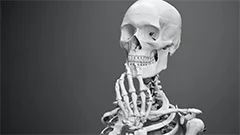Introduction
The maxilla, one of the two paired bones of the upper jaw in vertebrates, plays a crucial role in the facial skeleton and dental apparatus. This course aims to provide an in-depth understanding of the maxilla, its structure, development, and function within the context of osteology, with a focus on its significance in various taxa.
Definition and Location
The maxilla, also known as the upper jaw or the superior maxillary bone, is a complex bone that comprises several distinct parts: the palatine process, the zygomatic process, the alveolar process, and the maxillary body. It forms the anterior part of the hard palate and the lateral walls of the nasal cavity.
Structure and Morphology
Maxillary Body
The maxillary body is the central and largest portion of the maxilla. It forms the floor of the orbit, the medial wall of the maxillary sinus, and the anterior part of the hard palate. The maxillary body articulates with several other bones, including the frontal bone, nasal bones, lacrimal bones, zygomatic arch, and the mandible.
Alveolar Process
The alveolar process extends posteriorly from the maxillary body and houses the tooth sockets for the upper teeth (except for the incisors, which are housed in the premaxilla). The number and position of these sockets vary among different taxa. In humans, the alveolar process accommodates the maxillary premolars, canines, and molars.
Palatine Process
The palatine process is a vertical plate-like extension that forms the medial wall of the nasal cavity and the posterior part of the hard palate. The palatine processes from both sides meet at the midline to form the interpalatal suture, which ossifies later in life.
Zygomatic Process
The zygomatic process projects laterally and upward from the maxilla, forming the cheek region and articulating with the zygomatic bone to form the zygomatic arch. The zygomatic process contributes significantly to the facial profile in many taxa.
Development and Growth
The maxilla develops from the first branchial arch during embryonic development. It undergoes a series of morphological changes as it grows, including the formation of the palatine processes and the alveolar process. The growth of the maxilla is influenced by various factors, such as genetic regulation, hormonal signals, and mechanical forces.
Function and Clinical Significance
The primary functions of the maxilla include supporting the upper teeth, forming parts of the nasal cavity and hard palate, and contributing to facial structure. In addition, the maxilla serves as an attachment site for several muscles involved in chewing, speech, and facial expressions.
Clinically, disorders or injuries affecting the maxilla can have significant impacts on dental health, nasal function, and facial aesthetics. Fractures of the maxilla are common in facial trauma and may require surgical intervention for proper healing. Furthermore, congenital abnormalities or pathologies of the maxilla can lead to malocclusions, sleep apnea, and other health problems.
Comparative Anatomy
Mammals
In mammals, the maxilla exhibits considerable variation in size, shape, and development among different species. For instance, in some rodents and artiodactyls, the alveolar process is highly elongated to accommodate a greater number of teeth. In contrast, the maxilla of primates is relatively smaller due to their reduced tooth count.
Birds
The avian maxilla shares some similarities with its mammalian counterpart but has undergone significant modifications to accommodate the unique characteristics of birds, such as the presence of a beak and the absence of teeth. The avian maxilla forms part of the dentary in lower jawed reptiles, providing a clear example of homology between these structures.
Conclusion
The maxilla is an essential bone in the vertebrate skull, playing crucial roles in dental support, nasal function, and facial structure. Understanding the intricacies of its development, morphology, and clinical significance can provide valuable insights into various aspects of osteology and craniomandibular biology.
MCQ: Test your knowledge!
Do you think you know everything about this course? Don't fall into the traps, train with MCQs! eBiologie has hundreds of questions to help you master this subject.
These courses might interest you
Create a free account to receive courses, MCQs, and advice to succeed in your studies!
eBiologie offers several eBooks containing MCQ series (5 booklets available free for each subscriber).



